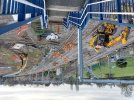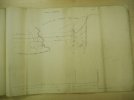Is that short term due to current position of signals or the final solution?
The Down would have needed realigning to get better geometry for the Up move which presumably is more beneficial for improving Jcn clearance times.
I have been to have a look, and I am mystified, because both of the relevant signals have been moved.
On the down road coming from Shepreth CA123 is the last signal before the junction. Until Christmas Eve it was positioned on the curve and can be seen next to the 13th wagon on the right edge of this picture, which is taken from the blue footbridge that crosses the track at the old junction:
66734 passing Shepreth Branch Junction

www.flickr.com
6M04 1157 Barrington Sidings, Foxton - Willesden 09-06-23
The 30mph board is partially obscured in the picture and is next to the 6th wagon. CA123 also had a banner repeater which was before the start of the curve, Shepreth side of the Shelford Road bridge.
The new CA123 is north of the old junction and the blue footbridge, roughly opposite the old CA140 signal* on the up road that had the feathers for the branch. It still has a banner repeater which has also been moved, now it is just before the blue bridge, roughly where the GN MP55¼ is next to the 4th wagon in the picture.
The first signal after the junction is CA141 and this has also been moved. Previously it was just after Dukes No 2 crossing, there is already no trace of the exact location, but the new CA141 signal is much further north, near to GE MP53¾ and the bridge over the Nine Wells stream. To give some idea of distance GE MP53 was next to the Websters crossing which is in the bottom left hand corner of the picture, so the new CA141 is a three-quarter mile north of the old junction.
Given that the track geometry is set up for 40 mph, and both signals have been moved, what has gone wrong so that the new signals have been placed in locations where sightlines are inadequate for 40 mph running?
*not directly relevant, but CA140 is also being moved further north, the new CA140 will be roughly in line with White Hill farm nearer to the Nine Wells stream than the old junction.




